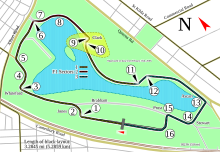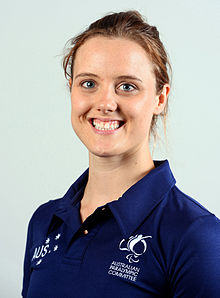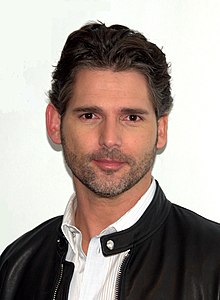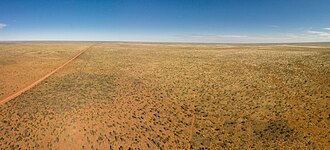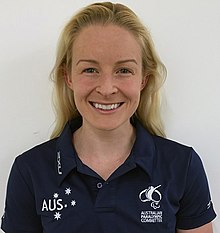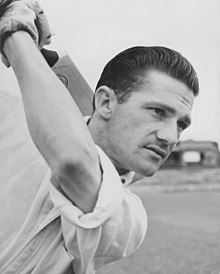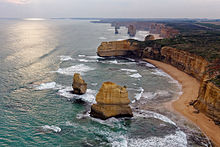| Portal page | WikiProject Victoria | WikiProject Melbourne | WikiProject Geelong |
The Victoria Portal


Victoria, commonly abbreviated as Vic, is a state in southeastern Australia. It is the second-smallest state (after Tasmania), with a land area of 227,444 km2 (87,817 sq mi); the second-most-populated state (after New South Wales), with a population of over 6.9 million; and the most densely populated state in Australia (30.6 per km2). Victoria's economy is the second-largest among Australian states and is highly diversified, with service sectors predominating.
Victoria is bordered by New South Wales to the north and South Australia to the west and is bounded by the Bass Strait to the south (with the exception of a small land border with Tasmania located along Boundary Islet), the Great Australian Bight portion of the Southern Ocean to the southwest, and the Tasman Sea (a marginal sea of the South Pacific Ocean) to the southeast. The state encompasses a range of climates and geographical features from its temperate coastal and central regions to the Victorian Alps in the northeast and the semi-arid northwest.
Named in honour of Queen Victoria, Victoria was separated from New South Wales and established as a separate Crown colony in 1851, achieving responsible government in 1855. The Victorian gold rush in the 1850s and 1860s significantly increased Victoria's population and wealth. By the time of Australian Federation in 1901, Melbourne had become the largest city in Australasia, and was the seat of Federal government until Canberra became the national capital in 1927. The state continued to grow strongly through various periods of the 20th and 21st centuries due to high levels of international and interstate migration. Melbourne hosts a number of museums, art galleries, and theatres; in 2016 a sports marketing company named it the world's sporting capital. (Full article...)
Selected image
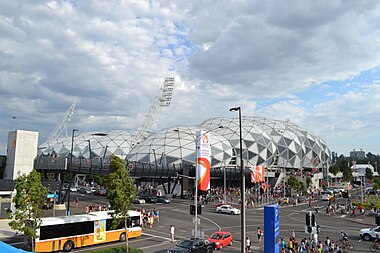
The Melbourne Rectangular Stadium, known as AAMI Park for sponsorship reasons, is an outdoor sports stadium on the site of Edwin Flack Field in the Sports and Entertainment Precinct in the Melbourne central business district.
When completed in 2010, it was Melbourne's first large purpose-built rectangular stadium. When the project to build the new stadium was approved, the largest stadiums in use were the Melbourne Cricket Ground (MCG) and Docklands Stadium. These were venues of oval configuration and best suited to Australian rules football or cricket. The previous largest rectangular stadium in the city, Olympic Park, was a repurposed track and field venue.
The stadium's major tenants are National Rugby League team Melbourne Storm, the Super Rugby team Melbourne Rebels, and the A-League teams Melbourne Victory FC and Melbourne City FC. It was also one of five venues for the 2015 AFC Asian Cup, hosting the opening match and six other matches including one quarter-final game, and it will host matches for the 2023 FIFA Women's World Cup. The venue hosted rugby league Four Nations matches in 2010 and 2014, and was used for the 2017 Rugby League World Cup.
Referred to as Melbourne Rectangular Stadium during its construction, the ground has been known as AAMI Park since it opened in March 2010, in a sponsorship deal with insurance firm AAMI.
Related portals
WikiProjects
Selected articles -
Did you know (auto-generated)

- ... that the government of Victoria, Australia, has a program to remove 110 level crossings by 2030, the fastest rate in the state's history?
- ... that Argentine naval officer Barry Melbourne Hussey was known as El Ingles ('The Englishman') by his comrades?
- ... that the Victoria State Government has ordered 100 G-class trams, which is the largest domestic order in Australian history?
- ... that Cheok Hong Cheong sold bananas for a decade, after which he became superintendent of the Church of England of Melbourne?
- ... that Genevieve Beacom became the first woman to pitch in the Australian Baseball League when she made her debut for the Melbourne Aces in 2022?
Subcategories
In the News (for Australia)
- 11 September 2024 – Israel–Hamas war protests
- Victoria Police arrest 39 people and fire stun grenades, rubber bullets, and pepper spray at anti-war and pro-Palestinian protestors picketing outside a military weapons expo in Melbourne, Australia. (Al Jazeera)
Topics
To-do list
Here are some tasks you can do to help at WikiProject Victoria:
-
Requests: - Missing topics
- Byrne, Victoria - request from pre 2016
- Local Government Association of Victoria - request from pre 2016
- Maroon, Victoria - request from pre 2016
- University of Western Victoria - request from pre 2016
- Lincoln Square (Melbourne)
- Awakenings Festival - Horsham
- Central Goulburn Irrigation Area
- Rochester Irrigation Area
- Wimmera Mallee Pipeline Project
- Heytesbury fires - (1886)
- Victoria bushfire season 1969 - Lara (1969)
- Barwon (region) - sub region of Barwon South West (region)
- Great South Coast (region) - sub region of Barwon South West (region)
- Loddon Campaspe (region) - sub region of Loddon Mallee
- Redlinks in navbox (Protected areas in Victoria)
- Aura Vale Lake Park (part of Cardinia Reservoir Parks)
- Barwon Bluff Marine Sanctuary
- Beechworth Historic Park
- Beware Reef Marine Sanctuary
- Birrarrung Park (part of Yarra Valley Parklands)
- Candlebark Park (part of Yarra Valley Parklands)
- Cape Liptrap Coastal Park
- Cardinia Creek Parklands
- Cardinia Reservoir Parks
- Corner Inlet Marine and Coastal Park
- Eagle Rock Marine Sanctuary
- Jawbone Marine Sanctuary
- Lake Tyers State Park
- Longridge Park Camp (part of Yarra Valley Parklands)
- Marengo Reefs Marine Sanctuary
- Maribyrnong Valley Parklands
- Maroondah Reservoir Park
- Merri Marine Sanctuary
- Mushroom Reef Marine Sanctuary
- Nooramunga Marine and Coastal Park
- Nortons Park (part of Dandenong Valley Parklands)
- Point Cooke Marine Sanctuary - part covered in Point Cook Coastal Park#Marine
- Point Danger Marine Sanctuary
- Point Gellibrand Heritage Park
- Ricketts Point Marine Sanctuary
- Shallow Inlet Marine and Coastal Park
- Shepherds Bush (Victoria) (part of Dandenong Valley Parklands)
- Silvan Reservoir Park
- Steiglitz Historic Park
- Sugarloaf Reservoir Parks
- The Arches Marine Sanctuary
- Tirhatuan Park (part of Dandenong Valley Parklands)
- Wabba Wilderness Park
- Wilsons Promontory Marine Park
- Wimmera River Heritage Area Park
- Woodlands Historic Park
- Yarra Flats Park (part of Yarra Valley Parklands)
- Yarra Valley Parklands
-
Expand: - stubs: 5,038
- List of schools in Victoria
- Mount Rothwell Biodiversity Interpretation Centre
- Melbourne Workers Theatre
- City West Water
- Belgrave Lantern Festival
- Red Tuesday bushfires - (1898)
- 1925–26 Victorian bushfire season - Black Sunday (1926)
- Linton Bushfire - (1998)
- 2003 Eastern Victorian alpine bushfires
- Mount Lubra bushfire - (2006)
- 2006–07 Eastern Victoria Great Divide bushfires
- Goulburn (region) - sub region of Hume (region)
- Ovens Murray (region) - sub region of Hume (region)
- Images: - requested images: 260

A list of articles needing cleanup associated with this project is available. See also the tool's wiki page and the index of WikiProjects.
Geelong To-do
|
|---|
|
Here are some tasks you can do to help at WikiProject Geelong:
 A list of articles needing cleanup associated with this project is available. See also the tool's wiki page and the index of WikiProjects. |
In other projects
The following Wikimedia Foundation sister projects provide more on this subject:
-
Commons
Free media repository -
Wikibooks
Free textbooks and manuals -
Wikidata
Free knowledge base -
Wikinews
Free-content news -
Wikiquote
Collection of quotations -
Wikisource
Free-content library -
Wikispecies
Directory of species -
Wikiversity
Free learning tools -
Wikivoyage
Free travel guide -
Wiktionary
Dictionary and thesaurus

